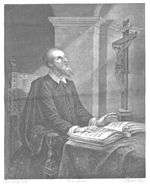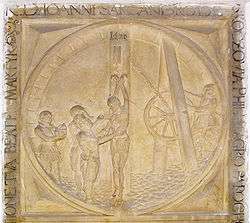Jan Sarkander
Saint Jan Sarkander (Czech and Polish: Jan Sarkander) (20 December 1576 – 17 March 1620[2]) was a Polish-Czech Roman Catholic priest.[3][4] Sarkander was married for a short period of time before he became widowed and pursued a path to the priesthood where he became active in the defense of the faith during a period of anti-Catholic sentiment and conflict. He himself was arrested on false accusations as a means of silencing him and he refused to give in to his tormenters who tortured him for around a month before he died.[5]
Saint Jan Sarkander | |
|---|---|
 1855 sketch. | |
| Priest; Martyr | |
| Born | 20 December 1576 Skoczów, Silesia, Crown of Bohemia (now Poland) |
| Died | 17 March 1620 (aged 43) Olomouc, Moravia, Crown of Bohemia (now the Czech Republic) |
| Venerated in | Roman Catholic Church |
| Beatified | 6 May 1860, Saint Peter's Basilica, Papal States by Pope Pius IX |
| Canonized | 21 May 1995[1], Olomouc, Czech Republic by Pope John Paul II |
| Feast | 17 March |
| Attributes |
|
| Patronage |
|
Pope Pius IX beatified Sarkander at Saint Peter's Basilica in 1860 and Pope John Paul II canonized him as a saint in 1995 on his visit to the Czech Republic.[6]
Life


Jan Sarkander was born on 20 December 1576 in Skoczów, Bohemia (now in Poland) into a Silesian household as the son of Georg Mathias Sarkander and Helene Górecka. He had one sister and three other brothers: Nicholas (a priest himself), Paul, and Wenceslas.[4] His father died in 1589 and so he moved alongside his mother and siblings to Příbor.[3] His mother remarried and gave birth to his half-brother Matthew. Sarkander believed he was going to become a priest but dropped the idea and instead married. He and his wife then settled in Brno. The marriage was short lived for his wife died one year after the couple married; the two were childless. He recommenced his priestly studies, deeply convinced now that God was calling him.[5][4]
Sarkander studied at the Olomouc college from 1597 until 1600 due to the plague which forced him to transfer to the Charles University in Prague on 20 October 1600 where he graduated with a master's degree in philosophical studies. He obtained further education from the Jesuits in Prague and received his doctorate in philosophical studies in 1603. He continued theological studies in Austria from 1604. He later underwent theological studies at the Graz University and passed his examinations on 21 December 1607. He was made a sub-deacon on 20 December 1608 and elevated into the diaconate on 16 March 1609.[6]
On 22 December 1607 he received the minor orders from Cardinal Franz von Dietrichstein. The Bishop of Olomouc Jan Křtitel Civalli ordained him to the priesthood on 22 March 1609 in Grozin and was assigned to work as a parish priest in Olmütz (Olomouc) until he was assigned to Holešov in 1616.[3] Baron von Lobkowitz from Moravia supported Sarkander's efforts to re-Christianize the region but the rich anti-Catholic landowner Bitowsky von Bistritz opposed him to the extent where he wanted Sarkander killed. The Thirty Years War began in 1618 and it saw a bitter conflict between the Protestants and Catholics and this forced him to flee to Poland on 17 May 1619 for a brief period of time when the Protestants occupied Holleschau; He made a pilgrimage to the Shrine of Our Lady of Czestochowa, and spent a few months in Cracow. Then he returned home.[3] Polish forces moved into the area in 1620 and battle seemed imminent so that February he met the field commander in procession with the Eucharist in a monstrance as a shield; the forces saw him come in. The Poles, being devout Catholics, dismounted and knelt. They promised him that the village would be spared destruction. The Jesuits also helped him to reconcile 200 non-Catholics to the faith but other non-Catholics were severely angered by this.[5]
In 1620—during the ongoing Bohemian Revolt—Protestant Moravian Estates (under von Bistritz) accused Sarkander of being a traitor and instigator and so he was tortured in the Olomouc prison. He was taken to Olmütz where he was tortured in an effort force him to provide them with information on Sarkander's friend Lobkowitz.[3] One reason for him being tortured was due to his refusal to divulge what was said under the seal of confession which priests are bound under. When tortured and forced to reveal details of Lobkowitz's confession, he replied, “I would choose, with God’s help, rather to be torn in pieces than sacrilegiously to violate the seal of confession.”
Sarkander was covered in flammable material and was set on fire. Lighted candles as well as feathers soaked in oil and sulfur placed on him and ignited.[6] The rack was used on him on 13 February and again on the 17 and 18th; it would last two to three hours. For one month he survived the attempt to burn him alive. The torture finally ended with his death on March 17, 1620.[5] He is acknowledged as a martyr. In 1720 his remains were exhumed and were deemed to be incorrupt.
The "Saint Jan Sarkander chapel" stands on the place of his torture at the top of Michael's Hill. The original torturing rack and Sarkander's gravestone are preserved here as well.
Sainthood
The beatification process opened under Pope Benedict XIV - in which he was titled as a Servant of God - but the process was interrupted and thus remained inactive following this. Pope Pius IX approved the fact that Sarkander was killed "in odium fidei" (in hatred of the faith) on 11 September 1859 and beatified him as a result on 6 May 1860.
For canonization one miracle was needed. One such healing was investigated and was later validated by the Congregation for the Causes of Saints on 12 July 1991. A medical board approved the miracle on 26 November 1992 while theologians followed suit on 5 February 1993; the C.C.S. also voted in approval on 9 March 1993. Pope John Paul II approved the miracle on 2 April 1993 and canonized Sarkander on his visit to the Czech Republic on 21 May 1995.
References
| Wikimedia Commons has media related to John Sarkander. |
- Chronique, Éditions; Larebière, Bruno (2013). Jean-Paul II (in French). Éditions Chronique. ISBN 979-10-90871-95-3.
- Saint Jan Sarkander Article in French
- "Saint Jan Sarkander". Saints SQPN. 31 May 2016. Retrieved 2 October 2016.
- "Saint John Sarkander". Santi e Beati. Retrieved 2 October 2016.
- "St. John Sarkander". Saint Kateri. Retrieved 2 October 2016.
- "Bl. John Sarkander". Catholic Encyclopedia. 1910. Retrieved 2 October 2016.